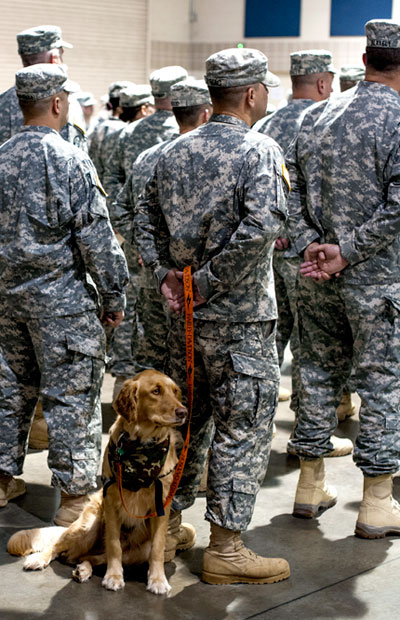The Department of Veterans Affairs (VA) has announced new rules expanding access to service animals and nonservice animals on VA properties, establishing a nationwide framework regarding the presence of animals at the VA.

Rosco, a post-traumatic stress disorder companion animal, stands behind his owner Sgt. 1st Class Jason Syriac, a military police officer with the North Carolina National Guard’s Headquarters and Headquarters Company, 130th Maneuver Enhancement Brigade, at his unit’s armory in Charlotte, N.C. (U.S. Army National Guard Photo by Staff Sgt. Mary Junell, 130th Maneuver Enhanced Brigade Public Affairs/Released)
The VA facility head will be authorized to allow guide, service and nonservice animals on VA property. Nonservice animals on VA property would have the same general restrictions of service animals in certain areas subject to patient safety, patient care, and infection control standards.
Under the expanded rules, announced in August 2015, unless the individual with a disability is receiving treatment in a VHA residential program, documentation is not required to gain access to VA property when accompanied by a service animal. The individual can be asked if the animal is required because of a disability, and what work or task the animal has been trained to perform.
There are limited circumstances in which nonservice animals will be permitted on VA property with approval:
- For law enforcement purposes
- If under the control of VA Office of Research and Development (ORD)
- If involved in animal-assisted therapy (AAT) for the therapeutic benefit of veterans
- If involved in animal-assisted activities (AAA) providing casual opportunities for motivational, educational, recreational, and/or therapeutic benefits
- If present for a residential animal program in a VA Community Living Center (CLC), a long term care setting providing nursing home care to veterans, fostering comfort while stimulating a sense of purpose, familiarity, and belonging. The animal would be permitted extended access only for the therapeutic benefit of veterans.
- If present for a Mental Health Residential Rehabilitation Treatment Program (MHRRTP), fostering comfort while stimulating a sense of purpose, familiarity, and belonging. The animal would be permitted extended access only for the therapeutic benefit of veterans.
- National Cemetery Administration could allow nonservice animals if present for ceremonial purposes during committal services, interments, and other memorials.
Examples of areas that animals may not access for safety reasons:
- Operating rooms and surgical suites
- Areas where invasive procedures are being performed
- Acute inpatient hospital settings, such as ICU, stabilization units, locked mental health units
- Decontamination areas
- Sterile processing areas
- Sterile storage areas
- Patient rooms or treatment areas where it is known that a patient has animal allergies, a fear or phobia of animals
- Food preparation areas
- Any area where personal protective equipment must be worn
Staff in VA facilities across the country should receive the new national criteria within the next month. VA facilities in several states already welcome service animals, though local procedure may change to meet the requirements of the new regulation.
“As I have traveled to VA facilities throughout the country, I have heard from many Veterans about what a vital role their service animals play in their lives,” Secretary of Veterans Affairs Robert A. McDonald said in a VA press release. “The revised regulation will ensure Veterans and employees have clear guidance regarding the presence of service animals in our facilities. VA remains committed to ensuring America’s Veterans have access to the health care benefits for which they are eligible.”
For decades, visually impaired veterans have received Veterans Health Administration (VHA) assistance in obtaining guide dogs. These guide dogs were allowed by federal regulation to be on VA property.
In contrast, the VHA began assisting mobility and hearing impaired veterans with service dogs within the last decade, and only eight veterans were reported as receiving VHA assistance with service dogs from 2008 – 2010. Service dogs can now assist veterans with physical, sensory, psychiatric, intellectual, or other mental disabilities. Unfortunately, unless authorized by the head of a VA facility, federal regulation did not allow service dogs or non-service animals on VA property. Facilities did not have consistent policy or processes for service animal assistance or access.
